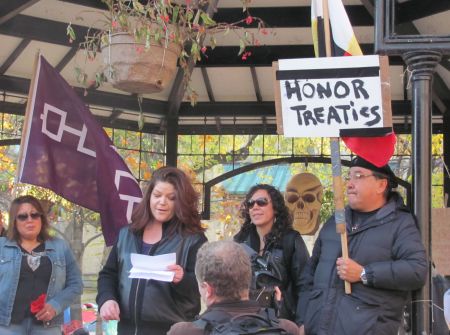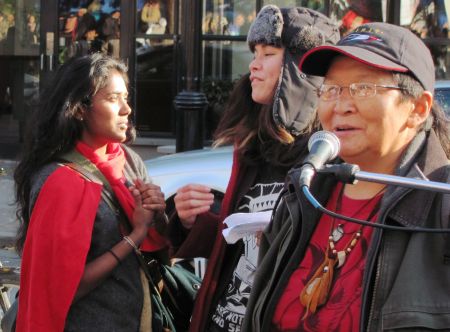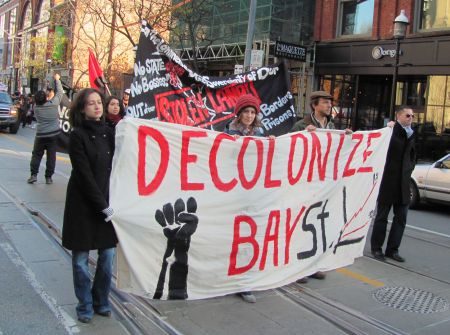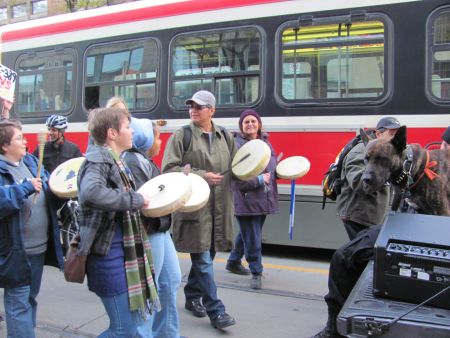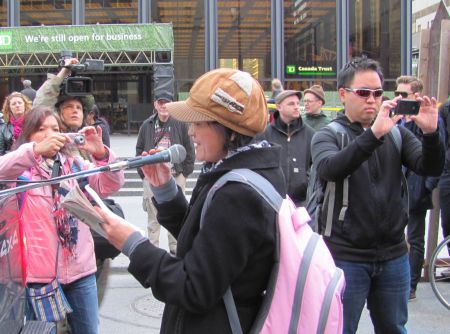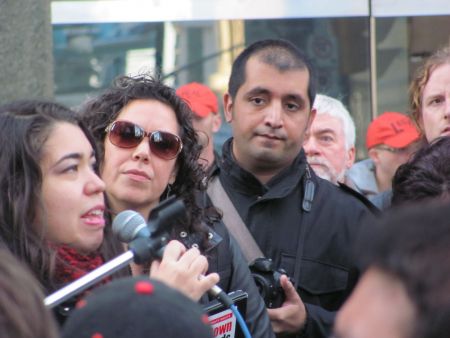“The Anishnabek of this territory support Occupy Toronto,” John Fox told a crowd of hundreds who gathered on the knolls of St. James Park. This was a declaration that many had been hoping for.
Discussion around the Occupy movement has shown that to Indigenous people, occupy is an ugly word. As Mohawk/Chinese activist Jessica Yee pointed out, “THIS IS INDIGENOUS LAND. And it’s been occupied for some time now.” Yee had waited awhile to see if the activists of Occupy Wall Street would mention that “New York City is Haudenosaunee Territory and home to many other first nations.” When she finally had to bring it up herself on Sept 30, she was mad.
The American Indian Movement has been on-site at Occupy TO Since Day One, to ensure the visibility of Indigenous people in the Toronto movement. It’s been a struggle, for even committed lefties tend to be blind to the ongoing genocide that freed the land for our obsessions and activities.
But a number of the St. James Park campers have been working for years on Indigenous solidarity and on issues like resource extraction, where theft and destruction of Indigenous lands is a daily reality. They’ve been working hard to educate their fellow campers. It all came together as Occupy Toronto celebrated its one-month anniversary with an Indigenous Solidarity March. Banners declared “(de)Occupy Toronto” and “Decolonize Bay St.”
John Fox told the “occupiers” that their presence was important at this time: that the Indigenous nations of Turtle Island had prophecies that their respectful ways would be lost for a time, and the land would be ruled by a spirit of materialism. But after generations of loss, there would come a time of reclamation and recovery.
“The Anishnabek call this the time of the Seventh Fire,” he said. “The time of the Seventh Fire is now.”
He told the crowd: “We honor women as our leaders,” and introduced some of the many women speakers who would lead and teach on the march.
Addressing the complex issues the democracy in the park faces day after day, Tannis Neilson advised: "The heart of the struggle is in community. If the forces that act upon us are operating globally, still our resistance must be local, and embody a diversity of tactics.”
The crowd was informed that democracy itself is indigenous to this place: “The Anishnabek have a constitution and a governance mode that are truly democratic. We also have the strategies and techniques to live in harmony with the land.” The disenfranchisement and exclusion from the economy that radicalized the Occupy campers, and the fear of violent eviction and arrest that they face is not new to Indigenous people: “We've been on the front line resisting these oppressive techniques for over 500 years.”
The speakers emphasized unity and solidarity: “We are all Indigenous from somewhere. We are all related to the land and we are united by the land. We all have the duty to protect the land from corporate destruction.”
As the community prepared to march, an elder offered a prayer, and asked the marchers to walk in a spirit of peace. “We want to show people that we are here together as a unity. We ask for less homelessness, for love, and to find our stolen children. We need to feel we belong, not to be treated like invisible people.”
The march on this day was a tour of entities that directly profit from theft of Indigenous land, including two kingpins of environmental destruction: Barrick Gold Corp and RBC. Based on Bay Street, Barrick calls itself “the world’s largest gold producer,” with mines on every continent. RBC is a chief financier of Alberta’s Tar Sands, which has been called “one of the most environmentally destructive projects on earth” and affects Indigenous communities in Alberta and BC, with nearby Fort Chipweyan as “the sacrifice zone” plagued by pollution and unexplained cancers.
Mining is a very dirty business that often involves the utter destruction of a piece of land, and thus the removal of a people and the complete loss of their way of life and a formerly viable economy. Canadian companies are active both at home and abroad. Bridge Cosme, of Binnadang-Migrante, an organization of Indigenous migrants from the Cordillera, explained how government and multinationals collaborate to shatter Indigenous communities in the Philippines:
“The Philippine Mining Act of 1995… initially rejected by the Philippine Supreme Court but put into law through former president Gloria Macapagal Arroyo's machinations, guarantees 100% foreign ownership of the land that allows displacement of the residents and removal of their houses and stripping of the forests.” The few jobs offered to locals cannot begin to make up for the utter loss of their lands and economies.
Ontario’s Mining Act is no better. Passed in 1873, it allows individuals and companies to secretly stake claims without landowner permission, on public, private and Indigenous land. In 2008, Robert Lovelace was jailed for trying to prevent toxic uranium extraction on Algonquin land, and six women and men from the Kitchenuhmaykoosib Innuniwug band were jailed for blockading unwanted platinum exploration.
Cosme related that, with 30% of the Philippines opened up for exploration to foreign and local mining companies, “Peoples' peaceful and militant resistance has always been met with violence. In fact, the present president, Benigno Aquino, approved the military proposal to allow privately-owned mining companies to form and fund militias.”
A stop at the American Consulate showed that such tactics occur on Turtle Island as well. Speakers called for the release of Leonard Peltier, seen by many as “America’s Nelson Mandela.” He was convicted in 1976 for 2 FBI deaths in a shootout that occurred during a period when, as encapsulated by Amnesty International, “more than 60 Indians on the Pine Ridge reservation had been killed, allegedly by paramilitary squads connected to the tribal government, without anyone being brought to justice for the crimes...” There is evidence of FBI collaboration with these squads on a war against traditionalists during those years, and enough documented instances of witness intimidation and evidence tampering for Amnesty to call for Peltier’s release.
As people interested in the Occupy movement have found, there is a vast difference between the way European-based cultures see the land, versus the way it is seen by the traditionalists in places like Pine Ridge and Fort Chipewyan. It shows in our use of language.
“The right word isn’t “occupy,” said a speaker. “It’s to “reclaim” public space. We are promoting the idea of the public good.” Marchers were told: “Our system, capitalism, is only one reality, and we don’t need that reality. We need to decolonize Bay Street. We need to decolonize our minds and ourselves.”
Approaching Queens Park after a three-hour tour, the hundred marchers left were chanting: “This is the revolution. Decolonize is the solution.” Those who remained were asked to continue their self-education and to join in movements that oppose developments like the Tar sands, and mining giants like Barrick who are destroying land and community in Indigenous territories.
Echoing John Fox’s declaration that the time is now, marchers were exhorted: “You are the people you have been waiting for.”
Links:
Indigenous Sovereignty Week: http://www.defendersoftheland.org/Toronto
Bulletins on Ontario Issues: http://chiefs-of-ontario.org/News/List.aspx
Jessica Yee: http://www.racialicious.com/2011/09/30/occupy-wall-street-the-game-of-colonialism-and-further-nationalism-to-be-decolonized-from-the-left/
Barrick: http://protestbarrick.net/article.php?id=593
Tar Sands:
http://understory.ran.org/2009/02/26/rbc-get-out-of-the-tar-sands/
http://www.tarsandswatch.org/tags/aboriginal-rights
Kitchenuhmaykoosib Innuniwug:
http://lakesuperiorminingnews.net/2008/12/31/community-unifies-to-defend...
